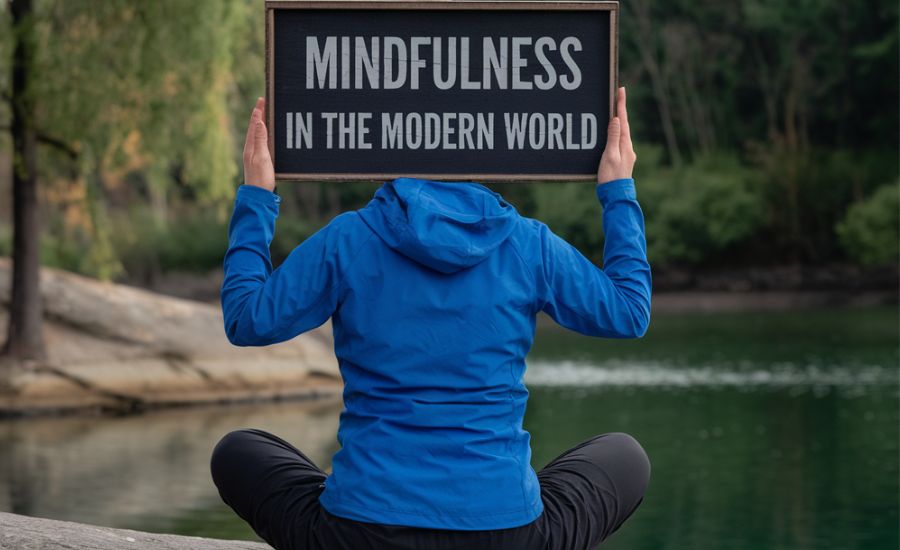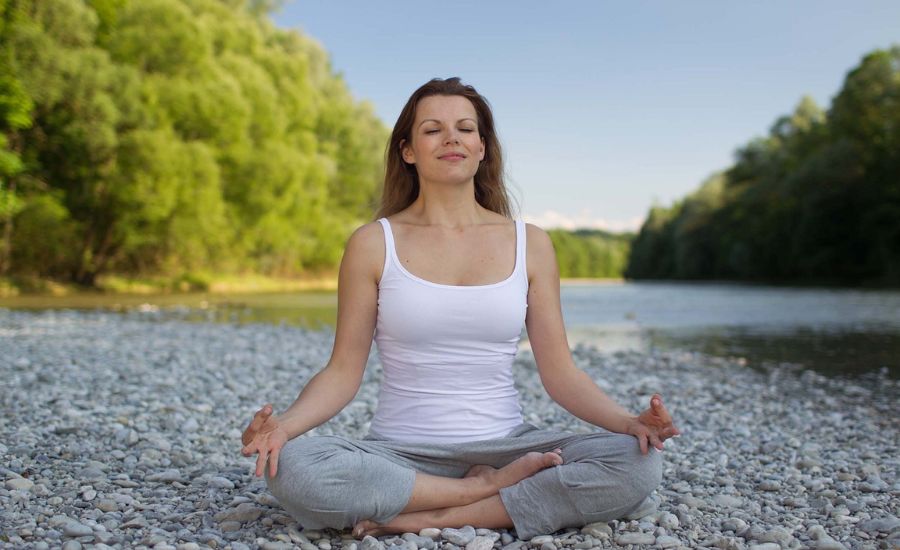Introduction
Mindfulness in the Modern Worldhas become an essential tool for mental health in a fast-paced society with many distractions and high levels of stress. Being present and completely involved in the moment, no matter what you’re doing, is the goal of mindfulness practice; it doesn’t entail spending hours quiet. The practical methods for incorporating mindfulness into everyday life are examined in this essay, making it available to anyone.
What is Mindfulness?
Mindfulness is the practice of maintaining a moment-by-moment awareness of your thoughts, feelings, bodily sensations, and environment. Rooted in Buddhist traditions, it has gained widespread recognition in modern psychology as an effective method for reducing stress, improving focus, and enhancing emotional regulation.
Research shows that Mindfulness in the Modern World regions of the brain associated with emotional regulation and self-awareness. People can reap major mental and physical health benefits by engaging in mindfulness practices on a regular basis.
The Benefits of Practicing Mindfulness Daily
Mindfulness has a tremendous impact on both the mind and the body. Among its most significant advantages are:
- Reduces stress and anxiety – Regular mindfulness practice lowers cortisol levels, the hormone responsible for stress, and promotes relaxation.
- Improves focus and productivity – Being present in the moment enhances cognitive function, making it easier to concentrate and make informed decisions.
- Enhances emotional regulation – Mindfulness fosters self-awareness, helping individuals respond thoughtfully rather than react impulsively.
- Promotes overall well-being – Encourages positive thinking and helps cultivate a healthier lifestyle by making individuals more attuned to their physical and emotional needs.
- Boosts resilience – Strengthens the ability to manage challenges and navigate difficult situations with a calm and composed mindset.
Practical Strategies to Incorporate Mindfulness into Daily Life
Many people believe mindfulness requires long meditation sessions, but it can be seamlessly integrated into daily routines. Below are practical strategies to help incorporate mindfulness into everyday life.
1. Mindful Breathing
Mindful breathing is one of the easiest and most effective Mindfulness in the Modern World techniques. It involves paying close attention to your breath, noticing how it flows in and out of your body.
How to practice:
- Exhale slowly through your lips after taking a deep breath through your nose and holding it for a short while.
- Focus on each breath, noticing the sensation of air entering and leaving your lungs.
- Repeat for a few minutes, gradually increasing the duration over time.
Practicing mindful breathing throughout the day, especially during stressful moments, can help restore calmness and clarity.
2. Mindful Eating
With busy schedules, many people eat their meals while distracted by screens or other tasks. Mindful eating encourages a more intentional and immersive experience with food.
How to practice:
- Eat slowly and chew thoroughly.
- Pay attention to your food’s flavors, textures, and scents.
- Don’t eat while using your phone or watching TV.
- Listen to your body’s hunger and fullness cues.
By focusing on the present moment while eating, individuals can cultivate a healthier relationship with food and improve digestion.
3. Mindful Walking
Walking mindfully allows you to connect with your surroundings and enhance body awareness.
How to practice:
- Walk at a comfortable pace, paying attention to each step.
- Take note of how your feet feel on the floor.
- Observe the sights, sounds, and smells around you.
- Breathe naturally and appreciate the present moment.
This simple practice transforms an everyday activity into a meditative experience.
4. Digital Detox and Mindful Technology Use

Technology is a major source of distraction and stress. Practicing mindful technology use helps maintain a healthy balance between digital and real-life experiences.
Tips for mindful technology use:
- Establish designated times to check social media and emails.
- Turn off non-essential notifications to reduce interruptions.
- Use Mindfulness in the Modern World apps that promote relaxation and focus.
Take regular screen breaks and practice the 20-20-20 rule (every 20 minutes, look at something 20 feet away for 20 seconds).
Reducing screen time allows for increased presence and connection in daily life.
5. Mindfulness in Conversations
Being fully present during conversations strengthens relationships and enhances communication skills.
How to practice:
- Listen attentively without formulating a response while the other person is speaking.
- Maintain eye contact and show genuine interest.
- Observe nonverbal cues such as facial expressions and body language.
- Avoid multitasking during conversations.
This approach fosters deeper connections and reduces misunderstandings in personal and professional relationships.
6. Gratitude Practice
Practicing gratitude shifts focus from stress and negativity to appreciation and positivity.
How to practice:
- Consider three things for which you are thankful at the conclusion of each day.
- Keep a gratitude journal and jot down positive experiences.
- Express appreciation to others through words or actions.
This simple habit promotes emotional well-being and increases overall happiness.
7. Mindful Journaling
Writing down thoughts and emotions without judgment fosters self-awareness and mental clarity.
How to practice:
- Set aside a few minutes daily to write about your thoughts and experiences.
- Focus on your emotions, observations, and insights.
- Avoid self-criticism and allow yourself to express freely.
Mindful journaling serves as a powerful tool for processing emotions and personal growth.
8. Mindfulness Meditation
Regular meditation enhances Mindfulness in the Modern World by training the mind to stay present.
How to practice:
- Find a quiet space and sit comfortably.
- Acknowledge thoughts as they arise and gently redirect focus to your breath.
- Start with 5-10 minutes and gradually increase duration.
Guided meditation apps like Headspace and Calm can help beginners establish a consistent practice.
9. Body Scan Awareness

The body scan technique helps identify areas of tension and promotes relaxation.
How to practice:
- Lie down or sit comfortably.
- Notice any tension or discomfort and consciously relax those areas.
- Breathe deeply and let go of any stress.
This practice enhances body awareness and improves sleep quality.
10. Bringing Mindfulness to Work
Practicing mindfulness in the workplace improves focus, efficiency, and job satisfaction.
Tips for workplace mindfulness:
- Take short breaks to reset focus.
- Begin meetings with a moment of silence.
- Engage in deep breathing exercises before stressful tasks.
- Prioritize single-tasking over multitasking.
Mindfulness at work leads to increased productivity and reduced burnout.
FAQ
1. How long does it take to see the benefits of mindfulness?
Most people experience improvements in stress levels and focus within a few weeks of consistent practice.
2. Do I need to meditate to be mindful?
No, Mindfulness in the Modern World can be practiced in daily activities like eating, walking, and working.
3. Can mindfulness help with anxiety and depression?
Yes, mindfulness-based interventions are proven to reduce symptoms of anxiety and depression.
4. How can beginners start practicing mindfulness?
Start with simple techniques like mindful breathing, gratitude journaling, or taking short meditation breaks.
5. Is mindfulness a religious practice?
While it has roots in Buddhism, mindfulness itself is a secular practice used in psychology and healthcare.
Conclusion
Mindfulness in the Modern World has become essential for preserving mental health in the fast-paced world of today. Being totally present in the moment entails increasing awareness of one’s thoughts, feelings, and environment. With roots in Buddhist traditions, mindfulness is now widely acknowledged in contemporary psychology for its ability to promote emotional regulation, enhance focus, and lower stress.
The everyday practice of Mindfulness in the Modern World can greatly improve one’s physical and mental health. It improves productivity, fortifies emotional resilience, reduces stress and anxiety, and advances general wellbeing. Incorporating mindfulness into daily routines can be facilitated by simple exercises like attentive breathing, eating, and walking. Reducing digital distractions, having thoughtful discussions, and maintaining a gratitude journal all help to promote emotional equilibrium and mental clarity.
Stay Ahead in Business Musk Game-Changing Innovations!









Leave a Reply